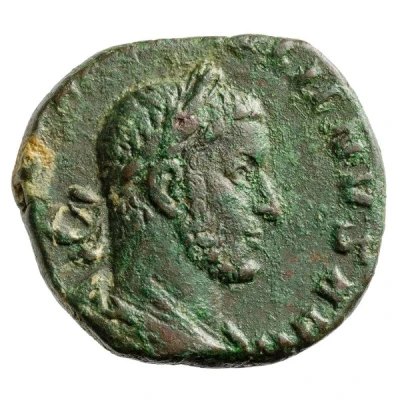


© Münzkabinett der Universität Göttingen (CC BY-NC 4.0 DE)
Sestertius - Gallienus VOTIS DECENNALIBVS S C
| Bronze | 17 g | 27 mm |
| Issuer | Rome › Roman Empire (27 BC - 395 AD) |
|---|---|
| Emperor | Gallienus (Publius Licinius Egnatius Gallienus) (253-268) Valerian (Publius Licinius Valerianus) (253-260) |
| Type | Standard circulation coin |
| Years | 253-256 |
| Value | Sestertius (⅛) |
| Currency | Antoninianus, Reform of Caracalla (AD 215 – 301) |
| Composition | Bronze |
| Weight | 17 g |
| Diameter | 27 mm |
| Shape | Round (irregular) |
| Technique | Hammered |
| Orientation | Variable alignment ↺ |
| Demonetized | Yes |
| Updated | 2024-10-05 |
| Numista | N#286841 |
|---|---|
| Rarity index | 100% |
Reverse
Legend inscribed within laurel-wreath.
Script: Latin
Lettering: VOTIS DECENNALIBVS S C
Translation:
Votis Decennalibus. Senatus Consultum.
Vows (prayers) for ten years of rule. Decree of the senate.
Comment
Mass varies: 13.91–22.96 g;Diameter varies: 25.5–30 mm;
Example of this type:
Münzkabinett der Universität Göttingen
Source:
Online Coins of the Roman Empire (OCRE)
Interesting fact
The Sestertius coin features an image of Gallienus, who was a Roman emperor who ruled from 253 to 268 AD. During his reign, he issued a number of reforms that aimed to restore the Roman Empire's economy and military, which had been weakened by previous conflicts and inflation. One of his most notable reforms was the introduction of a new currency system, which included the Sestertius coin. This coin was made of bronze and had a value of one-fourth of a denarius, which was the standard unit of currency at the time. The Sestertius coin was widely used throughout the Roman Empire and remained in circulation for many centuries, making it a valuable piece of history for collectors and historians today.